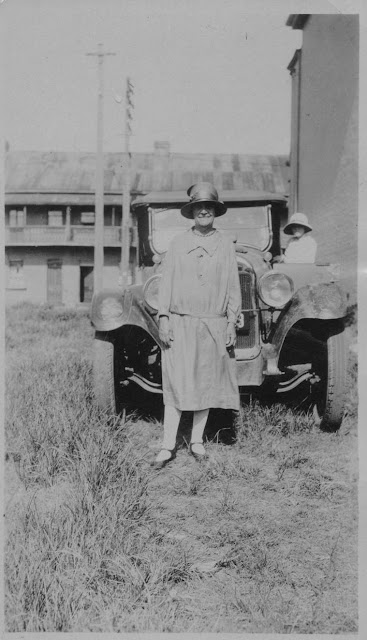CHAPTER 13 - DEATH, TENT SHOWS & KKK
 |
Chas and his three sons, Bill, Bert and Bob, 1926
|
Time and again I’ve looked at Grandfather’s past and wondered what made him the deviously aggressive sort of person he sometimes was. Could the cause and effect that resulted in the Chas Brown-Parker persona have first taken root back in the Bertie Brown childhood of Indiana?
I’ve taken you through the early years in Fiji, the show biz years in New Zealand, the scams and schemes in Sydney and Melbourne, the years of the first world war, the ‘ink pot’ controversy and the ignominy of the ‘Tar and Feather’ incident.
By this stage you could imagine Grandfather wanting to turn a new leaf, end out his days in the slow lane, give Maggie a welcome break from controversy. Think again.
oOo
1922. The Mildura court case has ended, a curious finding, guilty as charged but with the court’s sympathy. Sympathy or otherwise many are disgusted with the very suggestion of tarring and feathering anyone at all, no matter how much they deserved that punishment.
Grandfather hangs around Mildura until February of the next year when young Bert competes in the local swim club championships. He then takes the family on a whirlwind trek east through country New South Wales, first to Crookwell and then onto Singleton where he finds short term work on local newspapers.
How he transported the family the vast distance between towns is another mystery. Did he have a vehicle of sorts? Daughter Viti recalled him driving in the outback as a travelling salesman and we do have Maggie in photographs with splendid looking tourers; though I doubt the cars belonged to Grandfather.
 |
In this photo Maggie is wearing black for mourning, I can only imagine she is in Brisbane and the year is 1923
|
 |
A small daughter in the background, Rewa or Viti, the year could be 1921, the locality suburban Melbourne.
|
That print setting trade is coming in handy though ChasBert spends no more than a month or two in either town before ending up back in Queensland where he takes a position with a printing firm in Brisbane.
All of this I know because Grandfather loved accumulating work place references, either the few written by appreciative employers, or the many I strongly suspect he wrote himself on filched letter heads. In fact they all had a striking similarity of phrase.
In the same year, 1922, their son Charlie Andrew wins the Navy Flyweight boxing title. Charlie has been living away from the family since he joined the Navy. He represents the Royal Australian Navy in boxing tournaments around Australia while still being attached to the crew of the warship Tasmania.
You could say he is a chip off the old block.
By August of 1923 daughter Leota will have married Colin Young in Melbourne making absolute her separation from the family circus. She has a long memory and will never forgive her father for selling her hair.
oOo
1923 DEATH OF A SAILOR SON
New Zealand born Charles Andrew joined the Australian Navy in 1918 as a young lad of fourteen. He had a ready grin and a handy pair of fists and like his father he too was a boxer; at various times Chas senior organised exhibition matches putting his small sons in the ring to box their hearts out.
Young Charlie was a larrikin pure and simple; at one time he was also the Navy’s flyweight champion winning his matches in the 1922 Navy Championships held at Garden Island in Sydney.
POLICE STRIKE MELBOURNE 1923
In November of 1923 the city of Melbourne was paralysed by a police strike. Mobs gathered and rampaged through inner city streets looting and damaging shops and buildings. To protect Federal Government property, detachments of permanent naval, military and air force servicemen were posted help keep order.
AB Charles Andrew Brown-Parker, crewman from H.M.A.S Swan was struck on the head by a beer bottle in a violent clash while performing guard duty at Government House and died on the 5th of November in a Melbourne hospital. Charlie was only three months short of nineteen.
I couldn’t help thinking back to the chilling words written by a New Zealand journalist twenty years earlier when he described Chas senior as a useful man to have around during elections or any other kind of national disturbance. Like father like son.
 |
| The young sailor on the left is Charles Andrew |
The only known address the navy had for sailor Charlie’s next of kin was Olive Avenue, Mildura; but by November 1923, his parents Chas and Maggie were living thousands of miles away in Brisbane. Chas always spoke of his son as a hero, the recipient of a state burial through the streets of Melbourne.
In reality young Charlie was buried quietly in an unmarked grave and while his father applied for and received money from the Navy to place a headstone on the grave, he instead pocketed the cash and the grave remains unmarked.
oOo
Historical change is all the more fascinating when comparing before and now photographs. I look at Brisbane in 1910 when my grandparents first lived in Queensland’s capital city and life was lived at a slower pace, and then I look at today; at the frenetic life my children live.
Which do I really prefer? More to the point, which would they?
 |
Brisbane 1910
|




No comments:
Post a Comment
I love hearing from you, your comments good, bad or indifferent are always welcome..your anonymity will be respected. But remember if you want me to reply you will need to supply a contact email address otherwise I will never know who you are.